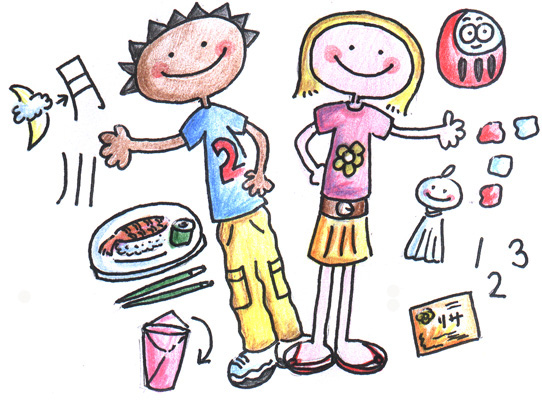Lesson 3
Lesson Plan Download pdf
Starter (10 minutes)
Ask children what currency they think is used in Japan. Explain that it is the yen and show various pictures of the different coins and notes (using the ‘how much?’ presentation). Compare the money to sterling - what are the similarities and differences? Discuss the images. What images are used on British notes? Why do children think those particular images were chosen? What picture might they choose to use on a £5/£10 note etc? Why?
Explain that although Japanese currency is the ‘en’, it becomes ‘yen’ when written in English (although it sometimes sounds like ‘yen’ depending on the preceding number).
Give the price of various items and ask the children to write down on their mini whiteboards/ scrap paper what they think the cost is. For example:
| 98 円です。 | kyujuhachi en desu. | It’ s 98 yen. |
Each phrase should be repeated 3 times and children should then display their answers.
Using the number presentation to assist, introduce children to the following:
| 百 | hyaku | one hundred |
| (so 110 would be 百十 hyakuju, 120 would be 百二十 hyakuniju etc) | ||
| 千 | sen | one thousand |
| 万 | man | ten-thousand |
Language Awareness Point
Large numbers in Japan are complicated by the fact that the counters ‘hyaku’ and
‘sen’ are altered by the preceding number. In this lesson, avoid 300, 600, 800, 3000
and 8000 if possible. These numbers are irregular. All other numbers follow regular
patterns. Look at the table on the next page:
| 100 | hyaku |
| 200 | ni hyaku |
| 300 | san byaku |
| 400 | yon hyaku |
| 500 | go hyaku |
| 600 | roppyaku |
| 700 | nana hyaku |
| 800 | happyaku |
| 900 | kyu hyaku |
| 1000 | sen |
| 2000 | ni sen |
| 3000 | san zen |
| 4000 | yon sen |
| 5000 | go sen |
| 6000 | roku sen |
| 7000 | nana sen |
| 8000 | hassen |
| 9000 | kyu sen |
| 10,000 | ichi man |
| 20,000 | ni man |
| 30,000 | san man |
| 40,000 | yon man |
| 50,000 | go man |
| 60,000 | roku man |
| 70,000 | nana man |
| 80,000 | hachi man |
| 90,000 | kyu man |
| 100,000 | ju man |
| 1 yen | ichi en |
| 10 yen | ju en |
| 100 yen | hyaku en |
| 1000 yen | sen en |
| 10,000 yen | ichi man en |
Unlike English, Japanese has a word for ten-thousand, which is pronounced as ‘ichi man’. Japanese is not alone in having a specific word for 10,000 - Chinese, Korean and some Indian languages amongst others also have this unit.
Repeat the initial exercise, using simple numbers (rounded to the nearest 10 for example) over 100.
As an extension, you could include other items known to the children. Are children able to work out what’s being said? For example:
| アイスクリームは 100 円です。 | Ice cream is 100 yen. |
| オレンジジュースは 120 円です。 | Orange juice is 120 yen. |
| ハンバーガーは 190 円です。 | Hamburgers are 190 yen. |
| メロンは 250 円です。 | Melons are 250 yen. |
Optional Extra:
Ask children to calculate the price of yen into pounds.
